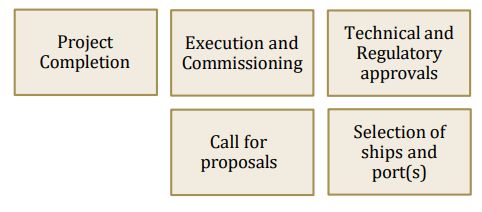The MNRE issued the Scheme Guidelines for implementation of Pilot projects for use of Green Hydrogen in the shipping sector ("Scheme for Shipping Sector") on February 1, 2024, under the Mission. The Scheme for Shipping Sector is in furtherance of the Mission's objective to decarbonize the economy, reduce dependence on fossil fuel imports, making India self-reliant and emerging as a global hub for production, usage, and export of green hydrogen. The future demand and trade of green hydrogen are heavily influenced by shipping and port operation making them the key drivers. To evaluate the potential of green hydrogen and its derivates, the Mission called for initiating pilot projects through the Ministry of Ports, Shipping and Waterways ("MoPSW").
The Mission provided 2 (two) components for supporting utilization of green hydrogen in the shipping sector. Firstly, retrofitting of existing ships to run on green hydrogen or its derivatives ("Component A") and secondly, development of bunkering and refueling facilities on ports for green hydrogen-based fuels ("Component B"). The SIA for Component A is going to be Shipping Corporation of India or its successors in case of disinvestment, and SIA for Component B is going to be nominated by MoPSW.
The Scheme for Shipping Sector aims to evaluate the economic viability of the use of green hydrogen and its derivatives in the shipping sector. It also targets to assess effectiveness, evaluate the performance and demonstrate safe and secure operations of green hydrogen and its derivates based propulsion system, bunkering and refueling systems.

Salient Features
1. SIAs are required to transparently award projects by following the General Financial Rules for selection/procurement. The executing agencies ("EA/s") are authorised to share knowledge and outcome of the projects vide completion and monitoring reports, publications, as well as best practices and lessons learned.
2. The Scheme for Shipping Sector would fund capital expenditure on the components and not expense of production. Financial assistance for projects is going to be based on the need, merit and feasibility.
3. A SC must oversee the Scheme for Shipping Sector and its projects, ensure their successful implementation and recommend adjustments as needed. It will also make suggestions to resolve difficulties arising in interpretation of the Scheme for Shipping Sector.
4. A PAC is required to assess project proposals for recommending sanction of funds, monitor the projects quarterly, and advice MNRE on release of the central financial assistance.
5. SIAs must provide quarterly monitoring reports to the MoPSW and MNRE and establish a mechanism to monitor progress of the pilot projects.
6. The call for proposals is required to include timelines and an extension (without penalty) of 6 (six) months may be granted basis adequate reasons approved by the SC. Extension beyond 6 (six) months must require approval from the MNRE and is subjected to penalties. EAs/ projects encountering unjustified delays or failing to adhere to objectives/provisions of the Scheme/Mission may be cancelled/shortclosed by the MNRE in consonance with the SC.
7. Terms and conditions set in the award must incorporate appropriate clauses to safeguard interests of the Government, should the EA fail to utilize the grant for its designated purpose or fail to complete the project.
8. As outlined within the Scheme for Shipping Sector, the MoPSW must release further guidelines to protect intellectual property rights resulted from the funded projects.
Scope and Funding of the Components
Component A includes retrofitting of existing oceangoing vessels with methanol/green ammonia based propulsion system or green fuel bases propulsion system, for those having and not having engine with electronic fuel injection system, respectively. It also includes retrofitting/development of an inland waterways vessel/ coastal waters ship with appropriate green methanol/green ammonia based propulsion system.
Under Component B, SIA is required to establish bunkering and refueling facilities as a pilot initiative, at a minimum of 1 (one) port along an international shipping route.
The Scheme for Shipping Sector must be executed with a total budgetary allocation of Rs 115,00,00,000 (Indian Rupees one hundred and fifteen crore) until financial year 2025-26, met from budget provisions under the Mission. An indicative, interchangeable and inter-se transferable allocation of INR 80,00,00,000 (Indian Rupees eighty crore) and INR 35,00,00,000 (Indian Rupees thirty-five crore) to Component A and B, respectively, has been made by the Scheme for Shipping Sector.
Implementation Approach
1. Selection of ships and ports: For Component A

SIA is required to identify ships suitable for retrofitting based on factors like size, route, and existing technology. They must ensure a diverse representation to assess various scenarios, and selected ships must have sufficient remaining operational life after retrofitting. For Component B, MoPSW is required to choose suitable port(s) and SIAs for establishing green hydrogen bunkering and refueling facilities.
2. Call for proposals: Call for proposals must be issued by and submitted to the SIAs. Eligible EAs include central public sector undertakings, state public sector undertakings, private sector entities, state corporations, Indian research and development institutions, academic institutions, and joint ventures or consortiums involving these entities, possessing the requisite capabilities to advance completed pilot projects towards commercialisation.
3. Evaluation and award: Proposals must be assessed by the PAC as per criteria provided in the call for proposal. The letter of award is required to be issued by the SIA upon approval from the MNRE.
4. Executing and commissioning: Projects must adhere to the approved scope of work. SIAs must strive to complete pilot projects by December 31, 2027, for Component A and by December 31, 2025, for Component B.
5. Technical and regulatory approvals: The EAs are solely responsible for obtaining necessary safety, environmental, and regulatory approvals.
6. Testing and certification: The EAs must ensure compliance with testing and certification requirements from relevant agencies.
7. Project completion: Within 1 (one) month of the completion of the project, SIA is required to submit a project completion report to the PAC, including technical components (i.e., the hardware, software, and technologies employed), challenges faced, and solutions implemented, project outcome (comprising the technical know-how generated and data collected), and suggestions for future projects based on lessons learned.
Conclusion
Worldwide, the shipping sector contributes approximately 3% of the total CO2 emissions. India's endeavour to diminish its carbon footprint will contribute to fulfilling the International Maritime Organization's objective of achieving a net-zero Greenhouse Gas ("GHG") emission by 2050.
As of March 2022, GHG emissions from maritime (excluding military operations) contribute to 1% to the overall transport sector GHG emissions i.e. approximately 2,744.34 Gg CO2e. Implementing Scheme for Shipping Sector will lead to development of requisite infrastructure such as refuelling stations, storage, and distribution networks, thereby establishing a green hydrogen ecosystem. Increase in usage of green hydrogen in the industry will be a natural consequence of reduction in its cost of production.
It is anticipated that the pilot projects will provide valuable insights for scaling up and commercially deploying green hydrogen in the shipping sector in the future. These initiatives will assist in identifying operational obstacles and shortcomings related to technological preparedness, regulatory compliance, implementation strategies, infrastructure, and logistical networks. The Scheme provides a compact framework for implementing the pilot projects, outlining clear objectives, eligibility criteria, evaluation processes, and monitoring mechanisms. Execution of the Scheme should be carried out in a way to ensure effective project implementation.
The content of this article is intended to provide a general guide to the subject matter. Specialist advice should be sought about your specific circumstances.


